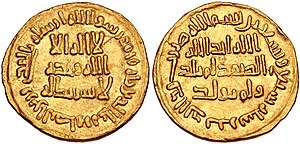| Sulayman ibn Abd al-Malik سُلَيْمَان ٱبْن عَبْد الْمَلِك | |||||
|---|---|---|---|---|---|
 Gold dinar minted under Sulayman, possibly in Damascus, in 715 or 716 | |||||
| 7th Caliph of the Umayyad Caliphate | |||||
| Reign | 24 February 715 – 24 September 717 | ||||
| Predecessor | Al-Walid I | ||||
| Successor | Umar | ||||
| Born | c. 675 Medina, Umayyad Caliphate | ||||
| Died | 24 September 717 (aged c. 42) Dabiq, Umayyad Caliphate | ||||
| Burial | Dabiq, Umayyad Caliphate | ||||
| Wives |
| ||||
| Issue |
| ||||
| |||||
| House | Marwanid | ||||
| Dynasty | Umayyad | ||||
| Father | Abd al-Malik ibn Marwan | ||||
| Mother | Wallada bint al-Abbas | ||||
| Religion | Islam | ||||
Sulayman ibn Abd al-Malik ibn Marwan (Arabic: سُلَيْمَان ٱبْن عَبْد الْمَلِك ٱبْن مَرْوَان, romanized: Sulaymān ibn ʿAbd al-Malik ibn Marwān, c. 675 – 24 September 717) was the seventh Umayyad caliph, ruling from 715 until his death. He was the son of Caliph Abd al-Malik ibn Marwan (r. 685–705) and Wallada bint al-Abbas. He began his career as governor of Palestine, while his father Abd al-Malik (r. 685–705) and brother al-Walid I (r. 705–715) reigned as caliphs. There, the theologian Raja ibn Haywa al-Kindi mentored him, and he forged close ties with Yazid ibn al-Muhallab, a major opponent of al-Hajjaj ibn Yusuf, al-Walid's powerful viceroy of Iraq and the eastern Caliphate. Sulayman resented al-Hajjaj's influence over his brother. As governor, Sulayman founded the city of Ramla and built the White Mosque in it. The new city superseded Lydda as the district capital of Palestine. Lydda was at least partly destroyed and its inhabitants may have been forcibly relocated to Ramla, which developed into an economic hub, became home to many Muslim scholars, and remained the commercial and administrative center of Palestine until the 11th century.
After acceding as caliph, Sulayman dismissed his predecessor's governors and generals. Many had been handpicked by al-Hajjaj and had led the war efforts which brought the Caliphate to its greatest territorial extent. Among them were the conqueror of Transoxiana (Central Asia), Qutayba ibn Muslim, who was killed by his own troops in an abortive revolt in anticipation of his dismissal, and the conqueror of Sind (the western Indian subcontinent), Muhammad ibn al-Qasim, who was executed. In the west, Sulayman deposed Musa ibn Nusayr, the conqueror of the Iberian Peninsula (al-Andalus) and governor of Ifriqiya (central North Africa), and had his son Abd al-Aziz, governor of al-Andalus, assassinated. Although he continued his predecessors' militarist policies, expansion largely stopped under Sulayman, partly due to effective resistance along the Central Asian frontiers and the collapse of Arab military leadership and organization there after Qutayba's death. Sulayman's appointee over the eastern Caliphate, his confidant Yazid, invaded the southern Caspian coast in 716, but withdrew and settled for a tributary arrangement after being defeated by the local Iranian rulers. Sulayman intensified the war with the Byzantine Empire, the primary focus of his war efforts, culminating in the 717–718 siege of Constantinople, which ended in a disastrous Arab defeat.
Sulayman died in Dabiq during the siege. His eldest son and chosen successor, Ayyub, had predeceased him. Sulayman made the unconventional choice of nominating his cousin, Umar, as caliph, rather than a son or a brother. The siege of Constantinople and the coinciding of his reign with the approaching centennial of the Hijra (start of the Islamic calendar), led contemporary Arab poets to view Sulayman in messianic terms.